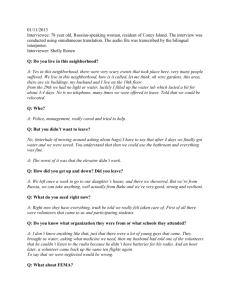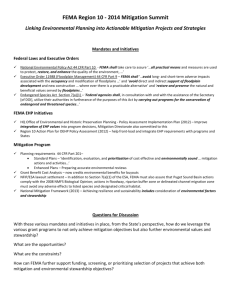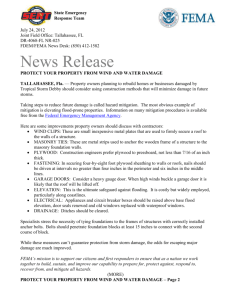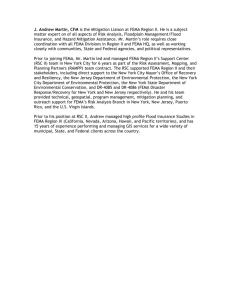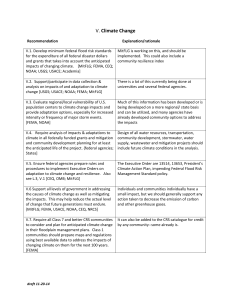- Public Risk Management Association
advertisement
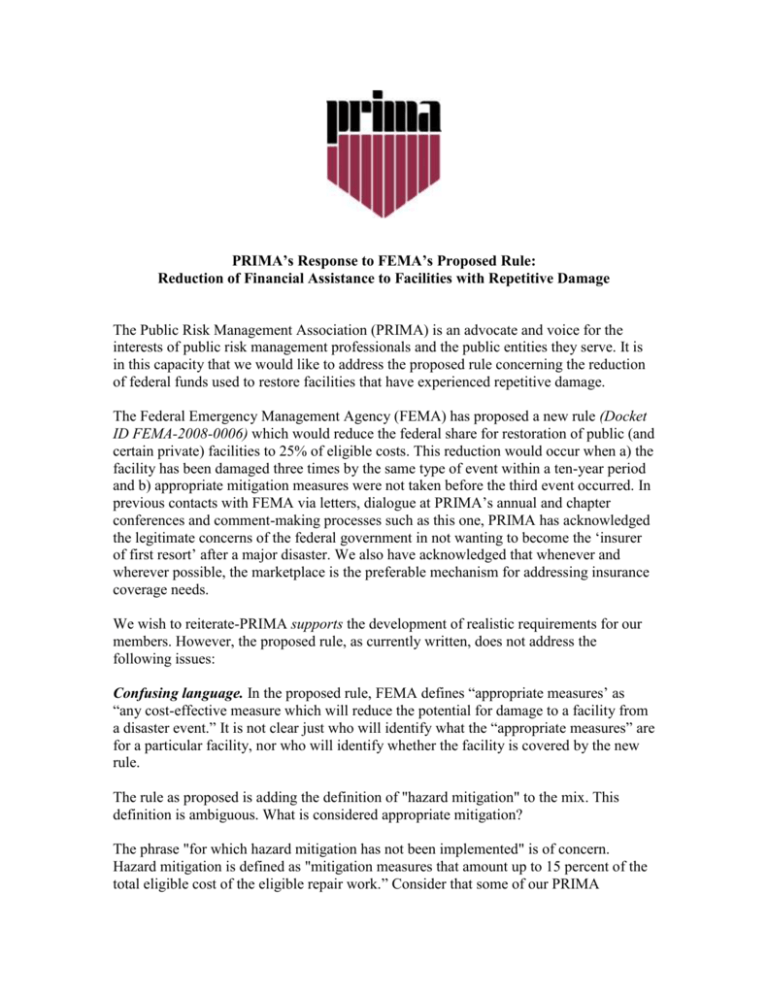
PRIMA’s Response to FEMA’s Proposed Rule: Reduction of Financial Assistance to Facilities with Repetitive Damage The Public Risk Management Association (PRIMA) is an advocate and voice for the interests of public risk management professionals and the public entities they serve. It is in this capacity that we would like to address the proposed rule concerning the reduction of federal funds used to restore facilities that have experienced repetitive damage. The Federal Emergency Management Agency (FEMA) has proposed a new rule (Docket ID FEMA-2008-0006) which would reduce the federal share for restoration of public (and certain private) facilities to 25% of eligible costs. This reduction would occur when a) the facility has been damaged three times by the same type of event within a ten-year period and b) appropriate mitigation measures were not taken before the third event occurred. In previous contacts with FEMA via letters, dialogue at PRIMA’s annual and chapter conferences and comment-making processes such as this one, PRIMA has acknowledged the legitimate concerns of the federal government in not wanting to become the ‘insurer of first resort’ after a major disaster. We also have acknowledged that whenever and wherever possible, the marketplace is the preferable mechanism for addressing insurance coverage needs. We wish to reiterate-PRIMA supports the development of realistic requirements for our members. However, the proposed rule, as currently written, does not address the following issues: Confusing language. In the proposed rule, FEMA defines “appropriate measures’ as “any cost-effective measure which will reduce the potential for damage to a facility from a disaster event.” It is not clear just who will identify what the “appropriate measures” are for a particular facility, nor who will identify whether the facility is covered by the new rule. The rule as proposed is adding the definition of "hazard mitigation" to the mix. This definition is ambiguous. What is considered appropriate mitigation? The phrase "for which hazard mitigation has not been implemented" is of concern. Hazard mitigation is defined as "mitigation measures that amount up to 15 percent of the total eligible cost of the eligible repair work.” Consider that some of our PRIMA member’s school districts are located along coastal areas where there has been major hurricane damage. In one district, damages totaled almost $30M. Another district in the same state had damages near $200M. Fifteen percent of either figure is a considerable expenditure for any one point in time. This amount is even more considerable given today's realities of budget constraints and lay-offs. In prior communications, we requested clear and consistent language in order to communicate FEMA’s expectations. Clarity on these issues is necessary. Unintentional consequences to public entities. The proposed rule has not taken into consideration the realities of mitigation funding for public entities. There are limited and varying funds in any given fiscal year as well as extraordinary competition for these dollars. If funding is not available to the applying entity, the new rule does not take into consideration the significant time and energy spent in attempting to acquire funds (if available). An entity could potentially be penalized even after making a good faith effort to obtain funds for mitigation. In the current economic climate, budgets of public entities are already stretched tremendously. Public entities cannot handle additional requirements without the availability of supplemental funding. Unrealistic expectations for hazard mitigation. In some cases, it is hard to mitigate exposures simply because of the unique financial stresses that local governments face. For instance, take flooding in a coastal county. The best way is to either: 1) rebuild on higher ground (well over 100% cost of normal rebuilding or 2) rebuild elsewhere. Neither is a viable option. To mitigate the exposure, public entities would have to virtually close their doors and rebuild in another jurisdiction in order to mitigate their flood exposure properly. Changes in FEMA personnel who deal with a disaster. During a disaster, FEMA sends teams of people to assist public entities. This team can change every 5-6 weeks and the entity involved has to start the process all over (these dynamics are still occurring with teams working on disaster relief from storms that occurred in 2005). Each team gives different information; each team requests the written documentation that has already been provided to FEMA (some of our members have had to do this as much as eight times) and each team interprets the Stafford Act differently. Problems with Project Worksheets (PWs). The section of the proposed rule concerning the tracking of project worksheets (PWs) by the National Emergency Management Information System (NEMIS) is complicated at best. Currently, FEMA's PWs do not track or follow insurance claim documentation or statements of values. The proposed rule says FEMA will use “the latitude and longitude documented on the PW and entered into NEMIS/EMMIE (Emergency Management Mission Integrated Environment)” in order to track repetitively damaged facilities. Does the rule take into consideration multiple buildings that exist at one latitude and longitude (which is a common situation for public entities)? The way the proposed rule is currently written does not address this issue. 2 Obtain and Maintain insurance requirements. The proposed rule would place an unfair burden on public entities because of the following: a) The insurance requirements are costly, at best and unavailable at worst for entities prone to flooding and wind damage. b) Mandating insurance requirements AND 15 percent of repair costs as additional expenditures to meet the definition of hazard mitigation is highly unreasonable. It is the duty of the public entities to provide services where the population exists- even if that population is in a flood, wind or seismic zone. Ten years is not a long enough period. Consider this example. In 2005, the state of Louisiana was hit with hurricanes Rita and Katrina. In 2008, the state was hit with hurricanes Gustav and Ike. It is conceivable that three events can (and will) occur in a 10year period to the same structure. PRIMA encourages FEMA once again to do the following: Continue to invite more input from public risk managers (as well as state and local public officials) before setting rules and polices that could have negative unintended consequences for public entities. PRIMA will continue to monitor and disseminate information regarding this issue and encourages its membership to do the same. 3

